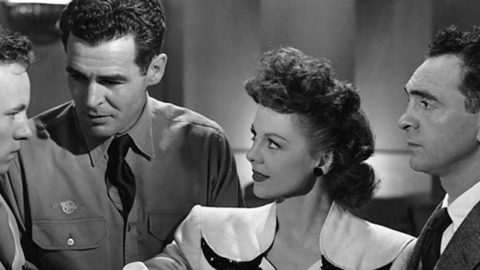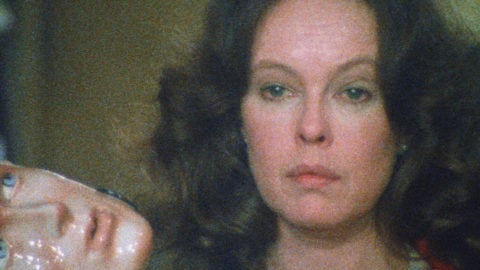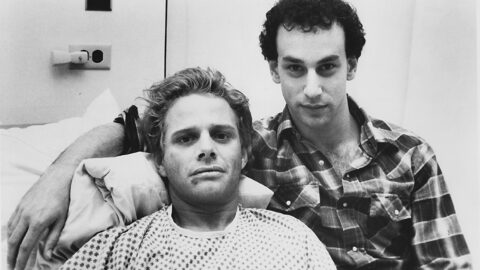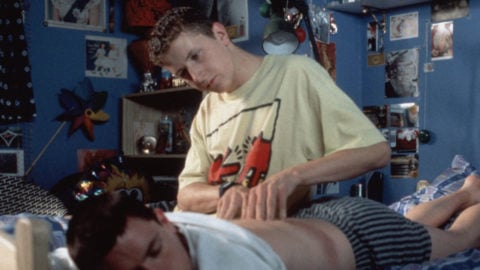Queer & Now & Then: 1999
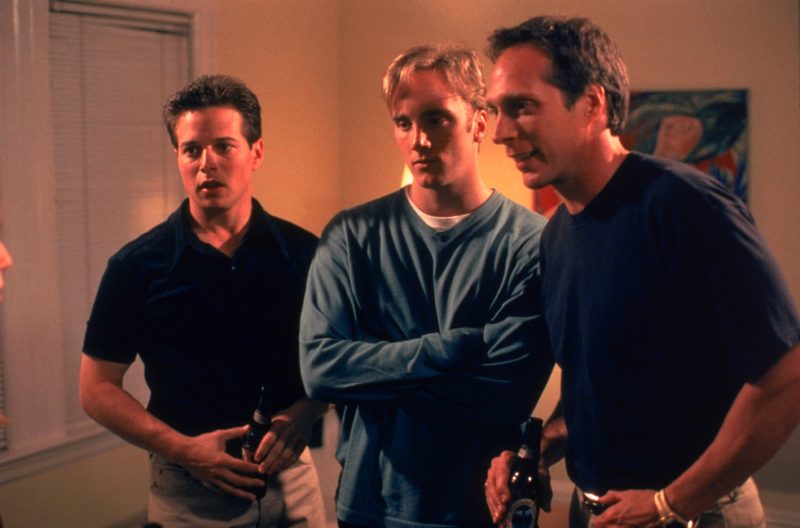
In this biweekly column, I look back through a century of cinema for traces of queerness, whether in plain sight or under the surface. Read the introductory essay.
In terms of queer representation in mainstream ’90s cinema, 1999 was the exception that proved the rule. For a long time now, the year has been perceived and commented upon as a kind of breakthrough moment of rule-flouting, a decade’s natural culmination by which time the tenets of scrappy independent cinema that defined the preceding 10 years were absorbed into the mainstream and audiences were allegedly more willing to accept the outré. In its bounty of homo-friendly studio-financed or -distributed movies, 1999 did seem to mark some kind of shift.
Looking back, however, it’s evident that this response was perhaps overzealous, and not just because in the Bush era of the early Aughts we were about to swing back into a dully conservative mode of de-sexualized, franchise-based Hollywood filmmaking that we have yet to crawl out from under. One needn’t look further than the queer characters in a handful of these films to see the conservatism lurking beneath the supposedly transgressive, from the murderously self-loathing gays of The Talented Mr. Ripley and (the Kevin Spacey–starring!) American Beauty, to the barfly sad-sackery of William H. Macy’s character in Magnolia, to the teasing angst of homoerotic repression that permeates Fight Club. And Charlie Kaufman’s precious male egos look at everything agog, so perhaps it’s not surprising that Cameron Diaz and Catherine Keener’s relationship in Being John Malkovich comes across as so sidelined and exotic (even the women’s happy romantic ending is strictly—literally—viewed through the perspective of its marginalized, forever trapped male protagonist). On the other hand, in Alexander Payne’s Election, burgeoning lesbian teen Tammy Metzler (Jessica Campbell) is the only main character to emerge with dignity and a potentially bright future, while Kimberly Peirce’s Boys Don’t Cry remains an exemplar of cinematic compassion, even if the terms of trans representation have changed rather drastically in the years hence. If we include Eyes Wide Shut—due to Alan Cumming’s amusingly horny hotel concierge and the brief image of two male orgy guests dancing, however chastely, to “Strangers in the Night”—then it seems the best American film of 1999 with no gay content was aptly titled The Straight Story.
While most of these films follow the Hollywood company line that queerness be more of a spicy side note or a lingering aftertaste than a main course, the sheer volume of gay characters here is at least noteworthy. For decades of moviemaking, gayness has equaled coyness, and that hasn’t changed even today. Yet there was one studio release from 1999 that directly and quite cleverly addressed the manner in which American films deploy homosexual characters and, more importantly, how audiences are instructed to engage—or more often, disengage—with them, and it was a considerably less prestigious or critically debated title than those listed above. In the ways it toys with viewer expectations, Doug Liman’s Go offers a far more complex inquiry into questions around gay representation, and the way it Trojan-horses its auto-critique into the film functions as a sly, surreptitious condemnation of the inherent homophobia of audiences and filmmakers alike.

At the time often tagged as a kind of “Pulp Fiction Jr.”, this triptych of interlocking stories centered around teen and twentysomething Angelenos was Liman’s film after his 1996 breakthrough Swingers, a mild takedown of aggressive male heterosexuality that nevertheless reveled in its own bravado, laying the groundwork for ostensible “critiques” like the HBO series Entourage. Out screenwriter and novelist John August, however, brought a different dimension to Liman’s follow-up, though it only reveals itself gradually. Right from the opening credits, which dive into the late-night whiz-bang rhythms of contemporary rave culture, it’s clear that Liman has abandoned the self-consciously retro stylings of Swingers, with its Rat Pack–aping guys on the prowl. Cleanly separating Go from Liman’s debut is that the first of the film’s trio of Christmas-set tales is told from the perspective of female characters, specifically Sarah Polley’s supermarket checkout clerk Ronna—who’s on an anxiety-provoking mission to score crucial rent money by taking over for out-of-town buddy Simon (Desmond Askew) in trying to seal a deal with a local drug dealer (a shirt-allergic Timothy Olyphant)—and Katie Holmes’s Claire, who’s reluctantly along for the ride.
The second tale falls more squarely into recognizable Swingers territory, as Simon gets into his own escalating troubles during a weekend bacchanal in Vegas with three other straight mates, though it must be noted that each of the actors playing them comes with a bit of queer baggage: Taye Diggs, whose breakthrough was co-starring in the AIDS-themed musical Rent on Broadway; Breckin Meyer of Clueless and the notoriously de-gayed 54; and James Duval, who was Gregg Araki’s standby beauty throughout the ’90s. (Nathan Bexton, also previously best known for his Araki connection, appearing as a gay extraterrestrial in Nowhere, gives Go’s first section a queer lift as well, playing Ronna and Claire’s sexually ambiguous, Molly-tweaked friend Manny.) The desultory banter between the guys occasionally verges on the homoerotic, especially considering all of their brash sex talk (“Pull your stinky dinky outta my ass!” complains Meyer when ragged on; Diggs is constantly extolling his own elongated tantric orgasms). The result of all this for the queer viewer is the sense of a kind of inconclusive inclusivity. But in the next section whatever simmering homoeroticism the film has thus far teased boils over.
And tease is the operative word for part three. Our main characters in this go-round are TV actors Adam and Zack, played by TV actors Scott Wolf and Jay Mohr—best known at the time for Party of Five and Saturday Night Live, respectively—and they’re introduced in parodic soap opera footage playing on the supermarket television, reciting corny lines (“Eden Valley will never stand for your kind of scum!”) and staring into each other’s eyes with those long, pregnant pauses in extreme close-up that are frequently mined for gay jokes. Indeed as the story starts, screenwriter August is already toying with viewers’ expectations that those gay jokes will arrive, a tactic that continues for much of the episode. As it opens, a stripped-to-undies Adam is getting wired for sound under the watchful—too watchful?—eye of Detective Burke (William Fichtner), who asks him about his workout regimen as he scans up and down his body. Instantly, the character (and the actor) is put in the position of being physically admired by the camera, as well as by another male character, a doubled, uncomfortable lasciviousness that inherently casts the objectified male as victim and the looker as predator; in mainstream movie terms—and most mainstream American comedy—this would seem to cast the recipient of unwanted looks as straight, and therefore his tormenter as the “opposite” of that. These are just unspoken, homophobic movie rules that Liman and August are deploying; we barely know these characters. Yet it’s worth asking who is truly the intended surrogate audience character: the chiseled soap opera actor, whose entire career is based on being looked at, or the one doing the looking?
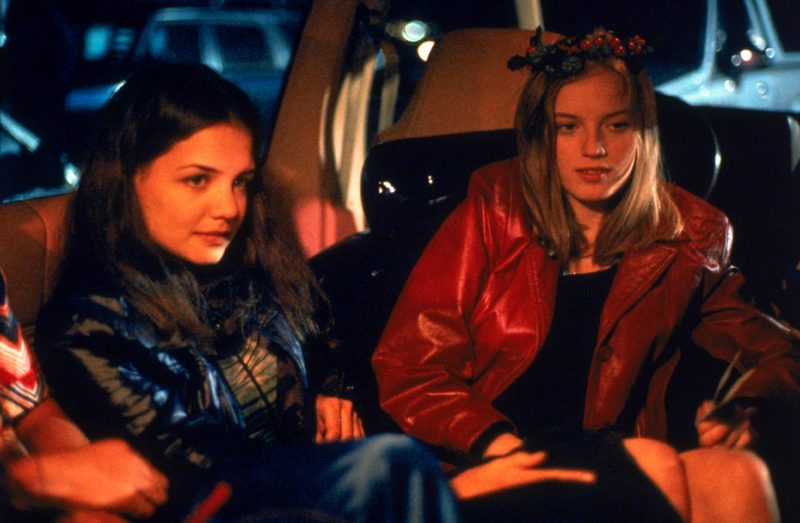
It soon becomes clear that Burke has coerced Adam and Zack into helping the cops score a dealer, which will help them get out of a potential drug charge and avoid jail time. While waiting for Adam to be fully wired and prepped for their mild sting operation, Burke asks a noticeably uncomfortable Zack personal and gratuitous questions about his girlfriend’s looks (“5 foot 8, brown hair, blue eyes,” responds Zack) and faithfulness (he claims to doubt her fidelity after finding another man’s socks in his home). Arriving at the checkout aisle looking for Simon so they can score some “E,” Adam and Zack instead encounter Ronna, who tells them he’s out of town but that she can help instead (initiating the action of the film’s first chapter). Adam and Zack appear fairly flirty with Ronna, which could be genuinely sexual or could just be due to their natural actorly gifts in trying to persuade her; nevertheless following this encounter and Zack’s explication of his relationship with his girlfriend, the viewer is confident enough in their heterosexuality that when a passing Claire sees them and remarks, “Gay men are so hot—it’s tragic,” we are meant to interpret her as being hilariously mistaken. As the film goes on to show, the internalized homophobic presumptuousness about Adam and Zack is not Claire’s but ours.
After the operation goes bust, Burke invites the boys to a home-cooked Christmas Eve dinner with his wife, Irene (Jane Krakowski), which they feel they cannot say no to. There, our suspicions about Burke are magnified after he strips nude in front of a visibly horrified Zack, asks him to smell his cologne (“CK One, right? But it’s not!” Burke mystifyingly responds), and brags about his mattress’s spring coils. Back in the kitchen, Irene acts even more sexually aggressive, sticking her tongue down Adam’s throat while she stirs the mashed potatoes. Properly put off and, like the audience, clearly expecting some kind of unwanted sexual initiation from these evident swingers (a different definition of Liman’s debut film title), Adam and Zack are instead met with a punch line: Burke and Irene are trying to coerce them into helping them sell imitation products in an Amway-like pyramid scheme. This doesn’t completely explain away Burke’s behavior, but retrospectively casts a different light on his aggressiveness and short circuits the character as a predator.
Burke effectively neutered, we’re left with Adam and Zack who, post-dinner and finally on their own for the first time in the narrative, reveal themselves to the audience. The butch boys are in fact a couple; the “hot girlfriend” Zack had been boasting about is Adam. The coyness of this entire episode until this point is both tactical and thematic, functioning as comic withholding while also speaking to the kid-gloves approach movies of the period would take to homosexuality. At the same time, it lightly yet definitively touches upon the shame associated with being out for working actors: though it’s never explicitly stated in the film, it’s Adam and Zack’s profession that likely requires them to remain in the closet. Overly straight-acting as Wolf and Mohr may be (and that works as text as well as extra-text), it’s unusual to the point of meaningful to hear them talk about giving and receiving blowjobs and amuse themselves over the discovery that they’re sleeping with the same guy (“Jimmy in makeup”). The rest of the segment is made up of narratively negligible hijinks, though as our two central characters are now unburdened by anxieties around playing pronoun games and dodging unwanted advances from sexually and morally ambiguous policemen, there’s a perceptible shift in tone, a kind of elated freedom. For unprompted straight viewers in 1999, this might have felt like a betrayal; for queer viewers, it’s something quite different: a sudden assurance of a safe space where none seemed to exist. A time of tentative strides and anxieties, the dominant ’90s culture was rife with gay panic jokes, most humorously in Seinfeld’s “The Outing” episode and most grotesquely in the “Gold Watch” chapter of Go’s widely cited forebear, Pulp Fiction. Go knowingly plays off of this tradition, using Hollywood vernacular—in this case, hetero bias—to bait and switch its viewers, setting up a litany of potential gay panic jokes to instead force its viewers into fully identifying with gay characters.
The circuitous, almost maddeningly tricky methods with which Go goes there isn’t just a clever storytelling gambit—it becomes a fairly spot-on evocation of the personal and cultural derangement of the closet. The tortuous ways that the boys, just like the film’s structure itself, play hide-and-seek with identity and eroticism, is a sort of screwball commentary on social conditioning. Liman’s film, as a mainstream studio product ostensibly preoccupied with people who fashion themselves as societal rule-breakers, is in no way a countercultural work, yet its characters are constantly negotiating public and private registers, journeying into the dangerous night to either hide or reveal their true selves. For Adam and Zack this negotiation is particularly acute: they are public figures, and everyone else seems to have erotic designs on or sexual presumptions about them. What makes Go a satisfying yet poignant queer film is that even after they have revealed themselves, the two men maintain their outsider status. They seem to have no interest in being ingested into hetero culture—the follies of which we viewers have been subjected to for the past 90-plus minutes. One doubts that in the new millennium to come these two will come out, let alone settle down and get married. It seems fitting that in the final year of the confusing 20th century, a film that keeps its characters in the closet would seem so freeing.
Michael Koresky is the Director of Editorial and Creative Strategy at Film Society of Lincoln Center; the co-founder and co-editor of Reverse Shot; a frequent contributor to the Criterion Collection; and the author of the book Terence Davies, published by University of Illinois Press.



